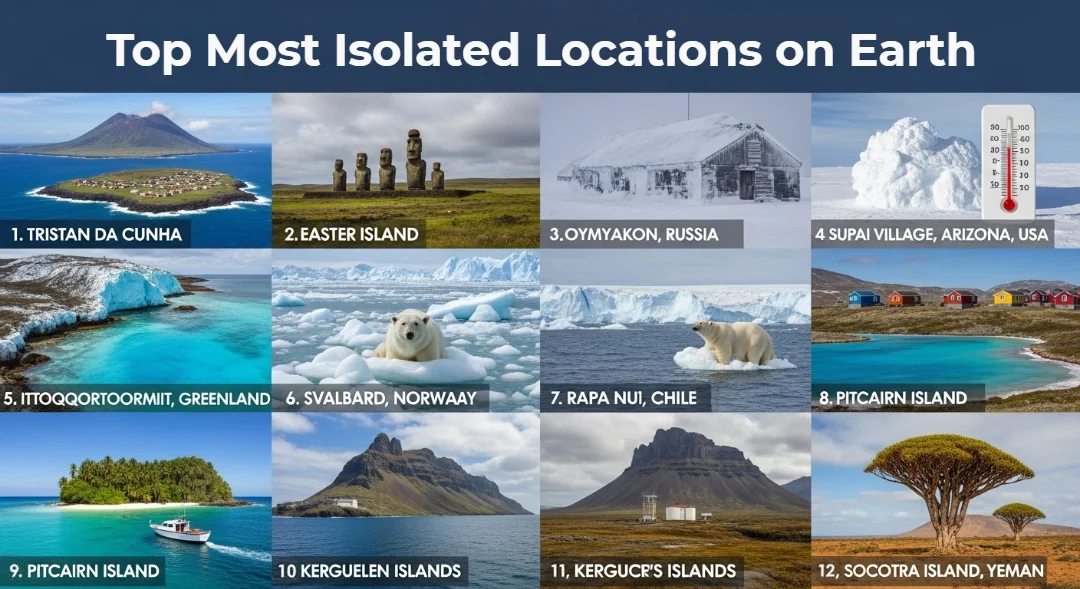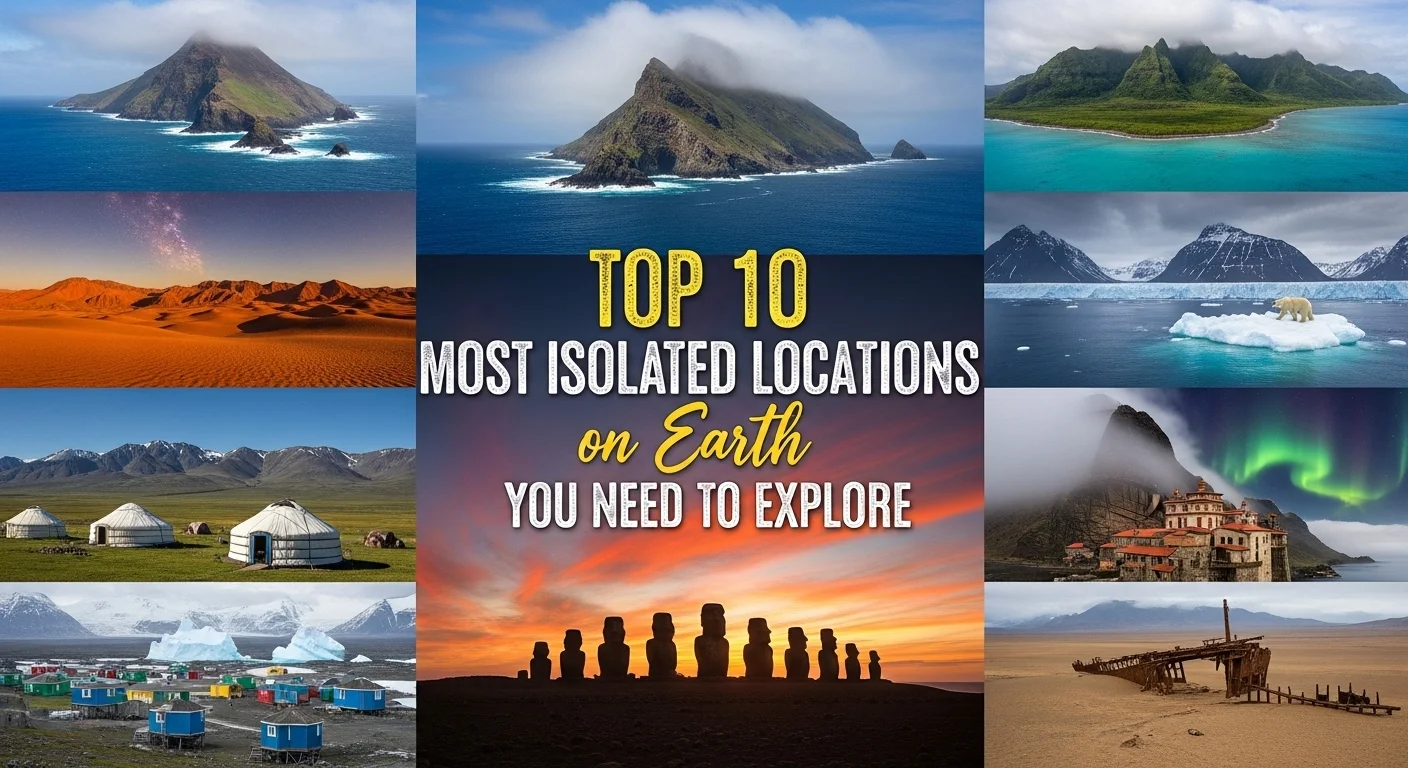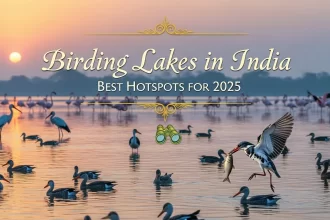Travel usually means navigating bustling cities, crowded markets, and well-trodden tourist paths. But for true adventurers who crave solitude and raw, untouched beauty, a different kind of journey awaits. The world’s most isolated locations on the Earth offer a chance to truly disconnect from modern life and reconnect with nature in its purest form. From distant islands to frozen expanses, these places prove that isolation is, in fact, the ultimate luxury.
If you’re ready to venture off the beaten path, here are the top 10 most isolated places on Earth that promise an adventure like no other.

1. Tristan da Cunha, South Atlantic Ocean
Why Go: Known as the world’s most remote inhabited island, Tristan da Cunha is home to a tiny community of fewer than 300 people. Its dramatic volcanic peaks, sheer cliffs, and unique bird species create an atmosphere of unparalleled seclusion. The journey here is as much of the adventure as the destination itself.
- How to Get There: Only accessible via a seven-day boat trip from Cape Town, South Africa.
- Best Time to Visit: December to March for milder weather.
2. Easter Island, Chile
Why Go: Famous for its mysterious stone Moai statues, Easter Island holds a place among the most isolated locations on Earth. Located over 2,000 miles from mainland Chile, its rich Polynesian heritage and incredible archaeological sites are truly fascinating.
- How to Get There: Regular flights from Santiago, Chile, land at Mataveri International Airport.
- Best Time to Visit: October to April for excellent weather and cultural events.
Must Read: 8 Incredibly Scenic Visa-Free Island Nations That Every Indian Traveler Must Visit at Least Once
3. Ittoqqortoormiit, Greenland
Why Visit: This tiny, colorful town on Greenland’s east coast is surrounded by majestic glaciers, pristine fjords, and the stunning Northern Lights. For an ultra-remote adventure travel experience, this is the place to be.
- How to Reach: You can only arrive by helicopter or via small expedition ships from Iceland or other Greenlandic settlements.
- Best Time to Visit: June to September for trekking and boat tours.
4. Pitcairn Islands, Pacific Ocean
Why Go: Inhabited by the descendants of the legendary Bounty mutineers, this tiny group of islands has a population of fewer than 50 people. It’s a truly secret, off-the-grid paradise.
- How to Get There: The only way to reach it is by sea from New Zealand, with very limited voyages per year.
- Best Time to Travel: May to October for drier weather.
5. La Rinconada, Peru
Why Visit: Sitting at an astonishing 16,000 feet above sea level, La Rinconada is the highest human settlement on the planet. Life here is incredibly challenging, but for travelers, it offers a glimpse into a rugged, high-altitude existence unlike any other.
- How to Reach: The journey requires extreme determination and high-altitude acclimatization to endure the remote mountain roads.
- Best Time to Visit: May to September when the skies are clear.
Must Read: 18 Most Dangerous Hiking Trails in National Parks Across The Globe That Only True Adventurers Can Conquer
6. Socotra Island, Yemen
Why Go: Dubbed the “Galápagos of the Indian Ocean,” Socotra is a truly surreal isolated location on Earth, famous for its bizarre Dragon Blood trees and unique, endemic wildlife found nowhere else in the world.
- How to Get There: Infrequent flights are available from mainland Yemen and sometimes other Gulf nations.
- Best Time to Visit: October to April for milder temperatures.
7. Oymyakon, Russia
Why Go: Officially the coldest permanently inhabited isolated location on Earth, Oymyakon regularly sees temperatures drop below –50°C. A visit here is an immersive dive into a frozen, unforgiving frontier.
- How to Get There: Travelers must first fly to Yakutsk, then endure a long, challenging road trip into the remote Siberian outback.
- Best Time to Go: December to February for the ultimate winter experience.
8. Kerguelen Islands, Indian Ocean
Why Visit: Also known as the “Desolation Islands,” this remote archipelago has no permanent residents, only a rotating group of scientists. Its raw, harsh mountains, colonies of penguins, and wind-lashed shores make it an eerily beautiful sight.
- How to Reach: Exclusively by boat, typically from Réunion Island.
- Best Time to Visit: December to March (austral summer) for marginally warmer weather and peak wildlife activity.
9. Svalbard, Norway
Why Visit: Located halfway between mainland Norway and the North Pole, Svalbard is a majestic icy wonderland of glaciers, polar bears, and the famous midnight sun. It’s an adventure into grand-scale isolation.
- How to Get There: Direct flights from Oslo or Tromsø, Norway, connect to Longyearbyen, the main settlement.
- Best Time to Visit: June to August for trekking, or November to January for tours of the polar night.
10. Soche Village, Malawi
Why Go: Hidden deep within the remote Mulanje Mountain region, Soche Village offers an unspoiled cultural encounter and stunning hiking opportunities. It’s a genuine, off-the-beaten-path gem among the most isolated locations on Earth you can visit.
- How to Get There: Reached from Blantyre via scenic but challenging hiking trails.
- Best Time to Travel: May to October during the dry season.
Conclusion
In a world that often feels small due to technology and rapid travel, the most isolated locations on the Earth are a powerful reminder that true wilderness and profound solitude still exist. They aren’t just about checking off a bucket list; they’re about rediscovering quiet, resilience, and a deeper connection with a planet that hides its greatest treasures in plain sight. If you seek a meaningful adventure far from the crowds, these secluded jewels should be at the very top of your list.
Must Read: Want a Foreign Vacation Feel? Try These 6 Stunning Foreign Vibe Destinations in Indian
FAQs (Frequently Asked Questions)
Q1: How difficult is it to travel to these isolated locations?
Ans: Travel to these locations can be very challenging. Many require long, multi-day boat trips, special flights, or difficult journeys by land, so they require significant planning and a high level of determination.
Q2: Are these destinations expensive to visit?
Ans: Yes, due to the extreme remoteness and limited access, travel to most of these places is very expensive. The cost is often high because of the specialized transport required, such as chartered boats or helicopters.
Q3: Is it safe to visit these extremely remote places?
Ans: Travel to these locations can involve risks due to their isolation and harsh environments. However, by traveling with experienced guides and tour operators, and by planning carefully, you can minimize the risks and have a safe adventure.
Q4: What kind of activities are available in these isolated locations?
Ans: Activities vary but often include unique experiences such as hiking and trekking, wildlife observation (penguins, polar bears), cultural immersion with local tribes, and exploring unique geological formations.
Q5: Which of these is the most isolated inhabited place?
Ans: Tristan da Cunha, a tiny island in the South Atlantic Ocean, is officially recognized as the most isolated inhabited place on Earth.
Q6: Do I need special permits to visit these destinations?
Ans: Some of these locations, especially those with fragile ecosystems or politically sensitive areas, may require special permits or visas. It is essential to research and arrange all necessary travel documents well in advance.







